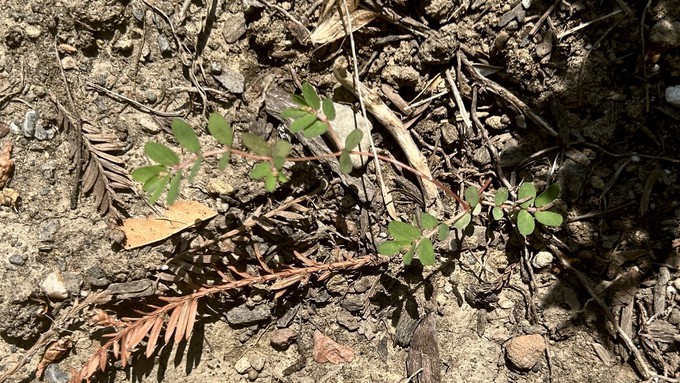
It's a Sisyphean battle, but don't surrender

Spurge is a scourge, spreading through microscopic seeds, but when small it can be dug out easily, unlike some weeds. Kathy Morrison
Not everyone hates weeds, I've discovered. Some gardeners have a "live and let live" attitude about the interlopers that shove their way into the garden, squatting next to the dahlias or cozying up to the tomatoes. Some folks even proclaim the beauty of weeds -- those little white flowers of field bindweed, for example. So pretty!
So dastardly, if you ask me.
Strictly speaking, a weed is any plant that grows where you don't want it. A tree of heaven (Ailanthus altissima) could be classified as a weed under this definition -- they move in unannounced all the time.
But most of us have garden-variety weeds to deal with: dandelions, crabgrass, nutsedge and the like. Lately, a variety of spurge has been our biggest problem -- my husband spent several hours digging it out of the front yard this past week so he could mow our small lawn without chopping the weeds into bits.
Why bother? The weeds ironically did make the lawn look greener. But, ugh, spurge and many other weeds can take over and choke out desirable plants. Which leads me to all the reasons to keep after weeds, as endless as the task may seem:
1) They're thieves. They suck up water, nutrients and sunlight that could be benefitting a garden's intentional plants.
2) They're opportunists. Given a little room to roam or soil to settle in, they develop tap roots, bulblike "nuts" or runners that take off into all corners. And this makes them tougher to remove.
3) They're thugs. Some such as bindweed can climb, envelop and throttle other plants. Others produce burrs that stick to pets or seeds with nasty thorns strong enough to pop a bicycle tire.
4) They can be outright dangerous. Pokeweed, for example, is toxic to humans and livestock -- all parts of it, not just the pretty berries. It's a perennial that produces a massive taproot that will help the plant grow back after winter.
5) They're hiding places for pests. This is why weeds shouldn't be ignored in winter. They can harbor bad bugs that will move into your ornamental or vegetable garden once the weather warms up.
All that said, into every gardener's life some weeds will sprout. It's part of what we get to share complaints about. So be good Earth residents, folks: Don't use broad-spectrum herbicides against those invaders. Mulch your planting beds. Find an excellent weed digging tool and keep at it. It's good exercise, after all.
Note: If you're interested in learning more about weeds, the UC Integrated Pest Management program website (which includes the links above) is invaluable. Also, check out the latest edition of the UCIPM Home and Garden Pest Newsletter. It includes an article "How can weed control help with wildfire preparedness?" Yes -- a sixth reason to keep after weeds: They can dry out in summer and become easy fuel for fires.
Comments
0 comments have been posted.Sacramento Digs Gardening to your inbox.
Sites We Like
Garden Checklist for week of Oct. 27
It's still great weather for gardening. Grab a sweater – and an umbrella, just in case – then get to work:
* October is the best month to plant trees, shrubs and perennials.
* Harvest pumpkins and winter squash.
* Pick apples and persimmons. Remember to pick up fallen fruit, too; it attracts pests.
* Clean up the summer vegetable garden and compost disease-free foliage.
* Dig up corms and tubers of gladioli, dahlias and tuberous begonias after the foliage dies. Clean and store in a cool, dry place.
* Treat azaleas, gardenias and camellias with chelated iron if leaves are yellowing between the veins.
* Now is the time to plant seeds for many flowers directly into the garden, including cornflower, nasturtium, nigella, poppy, portulaca, sweet pea and stock.
* Plant seeds for radishes, bok choy, mustard, spinach and peas.
* Plant garlic and onions.
* Set out cool-weather bedding plants, including calendula, pansy, snapdragon, primrose and viola.
* Reseed and feed the lawn. Work on bare spots.